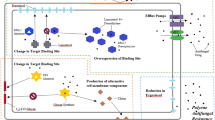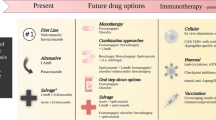Abstract
Isavuconazole is a second-generation triazole with activity against a broad spectrum of clinically important fungi. Its water-soluble prodrug, isavuconazonium sulfate (Cresemba®), available in interchangeable intravenous and oral formulations, is approved in the USA and EU for the treatment of adults with invasive aspergillosis and mucormycosis. In international phase III clinical trials, isavuconazole was efficacious and generally well tolerated in the treatment of these life-threatening diseases. In the phase III SECURE trial, isavuconazole was non-inferior to voriconazole for the primary treatment of invasive mould disease (primarily aspergillosis) and was associated with fewer drug-related treatment-emergent adverse events (TEAEs) than voriconazole. In addition, the single-arm, phase III VITAL trial and a matched case–control analysis of isavuconazole- versus amphotericin B-treated patients provided evidence of the efficacy of isavuconazole in the treatment of mucormycosis. The most commonly reported TEAEs among isavuconazole recipients were gastrointestinal disorders such as nausea, vomiting and diarrhoea. Isavuconazole has several other attributes that make it a useful new treatment option for these invasive mould diseases, including predictable pharmacokinetics, excellent bioavailability, no food effect with the oral formulation, and its potential utility in renally impaired patients given the absence of cyclodextrin in the intravenous formulation.

Similar content being viewed by others
References
Enoch DA, Ludlam HA, Brown NM. Invasive fungal infections: a review of epidemiology and management options. J Med Microbiol. 2006;55(7):809–18.
Badiee P, Hashemizadeh Z. Opportunistic invasive fungal infections: diagnosis & clinical management. Indian J Med Res. 2014;139(2):195–204.
Maertens J, Groll AH, Cordonnier C, et al. Treatment and timing in invasive mould disease. J Antimicrob Chemother. 2011;66(Suppl 1):i37–43.
Kontoyiannis DP, Marr KA, Park BJ, et al. Prospective surveillance for invasive fungal infections in hematopoietic stem cell transplant recipients, 2001–2006: overview of the Transplant-Associated Infection Surveillance Network (TRANSNET) database. Clin Infect Dis. 2010;50(8):1091–100.
Skiada A, Pagano L, Groll A, et al. Zygomycosis in Europe: analysis of 230 cases accrued by the registry of the European Confederation of Medical Mycology (ECMM) Working Group on Zygomycosis between 2005 and 2007. Clin Microbiol Infect. 2011;17(12):1859–67.
Maschmeyer G, Haas A, Cornely OA. Invasive aspergillosis: epidemiology, diagnosis and management in immunocompromised patients. Drugs. 2007;67(11):1567–601.
Mousset S, Buchheidt D, Heinz W, et al. Treatment of invasive fungal infections in cancer patients—updated recommendations of the Infectious Diseases Working Party (AGIHO) of the German Society of Hematology and Oncology (DGHO). Ann Hematol. 2014;93(1):13–32.
Denning DW, Hope WW. Therapy for fungal diseases: opportunities and priorities. Trends Microbiol. 2010;18(5):195–204.
Flückiger U, Marchetti O, Bille J, et al. Treatment options of invasive fungal infections in adults. Swiss Med Wkly. 2006;136(29–30):447–63.
Patterson TF, Thompson GR 3rd, Denning DW, et al. Practice guidelines for the diagnosis and management of aspergillosis: 2016 update by the Infectious Diseases Society of America. Clin Infect Dis. 2016;63(4):e1–60.
Lass-Flörl C. Triazole antifungal agents in invasive fungal infections: a comparative review. Drugs. 2011;71(18):2405–19.
Astellas Pharma US Inc. Cresemba® (isavuconazonium sulfate): US prescribing information. 2015. https://www.astellas.us/docs/cresemba.pdf. Accessed 3 Oct 2016.
European Medicines Agency. Cresemba: summary of product characteristics. 2015. http://www.ema.europa.eu. Accessed 03 Oct 2016.
Ghannoum MA, Rice LB. Antifungal agents: mode of action, mechanisms of resistance, and correlation of these mechanisms with bacterial resistance. Clin Microbiol Rev. 1999;12(4):501–17.
Thompson GR 3rd, Wiederhold NP. Isavuconazole: a comprehensive review of spectrum of activity of a new triazole. Mycopathologia. 2010;170(5):291–313.
Warn PA, Sharp A, Denning DW. In vitro activity of a new triazole BAL4815, the active component of BAL8557 (the water-soluble prodrug), against Aspergillus spp. J Antimicrob Chemother. 2006;57(1):135–8.
Perkhofer S, Lechner V, Lass-Flörl C. In vitro activity of isavuconazole against Aspergillus species and zygomycetes according to the methodology of the European Committee on Antimicrobial Susceptibility Testing. Antimicrob Agents Chemother. 2009;53(4):1645–7.
Datta K, Rhee P, Byrnes E 3rd, et al. Isavuconazole activity against Aspergillus lentulus, Neosartorya udagawae, and Cryptococcus gattii, emerging fungal pathogens with reduced azole susceptibility. J Clin Microbiol. 2013;51(9):3090–3.
Arendrup MC, Jensen RH, Meletiadis J. In vitro activity of isavuconazole and comparators against clinical isolates of the Mucorales order. Antimicrob Agents Chemother. 2015;59(12):7735–42.
Verweij PE, González GM, Wiederhold NP, et al. In vitro antifungal activity of isavuconazole against 345 Mucorales isolates collected at study centers in eight countries. J Chemother. 2009;21(3):272–81.
European Medicines Agency. European public assessment report: Cresemba (isavuconazole). 2015. http://www.ema.europa.eu. Accessed 03 Oct 2016.
Seyedmousavi S, Brüggemann RJ, Meis JF, et al. Pharmacodynamics of isavuconazole in an Aspergillus fumigatus mouse infection model. Antimicrob Agents Chemother. 2015;59(5):2855–66.
Warn PA, Sharp A, Mosquera J, et al. Comparative in vivo activity of BAL4815, the active component of the prodrug BAL8557, in a neutropenic murine model of disseminated Aspergillus flavus. J Antimicrob Chemother. 2006;58(6):1198–207.
Kovanda LL, Petraitiene R, Petraitis V, et al. Pharmacodynamics of isavuconazole in experimental invasive pulmonary aspergillosis: implications for clinical breakpoints. J Antimicrob Chemother. 2016;71(7):1885–91.
Lepak AJ, Marchillo K, VanHecker J, et al. Isavuconazole (BAL4815) pharmacodynamic target determination in an in vivo murine model of invasive pulmonary aspergillosis against wild-type and cyp51 mutant isolates of Aspergillus fumigatus. Antimicrob Agents Chemother. 2013;57(12):6284–9.
Petraitis V, Petraitiene R, Moradi PW, et al. Pharmacokinetics and concentration-dependent efficacy of isavuconazole for treatment of experimental invasive pulmonary aspergillosis. Antimicrob Agents Chemother. 2016;60(5):2718–26.
Luo G, Gebremariam T, Lee H, et al. Isavuconazole therapy protects immunosuppressed mice from mucormycosis. Antimicrob Agents Chemother. 2014;58(4):2450–3.
Lepak AJ, Marchillo K, VanHecker J, et al. Isavuconazole pharmacodynamic target determination for Candida species in an in vivo murine disseminated candidiasis model. Antimicrob Agents Chemother. 2013;57(11):5642–8.
Marty FM, Ostrosky-Zeichner L, Cornely OA, et al. Isavuconazole treatment for mucormycosis: a single-arm open-label trial and case-control analysis. Lancet Infect Dis. 2016;16(7):828–37.
Desai AV, Kovanda LL, Hope WW, et al. Exposure-response analysis of isavuconazole in patients with disease caused by Aspergillus species or other filamentous fungi [abstract no. P0217 plus poster]. In: 25th European Congress of Clinical Microbiology and Infectious Diseases. 2015.
Chowdhary A, Sharma C, van den Boom M, et al. Multi-azole-resistant Aspergillus fumigatus in the environment in Tanzania. J Antimicrob Chemother. 2014;69(11):2979–83.
Chowdhary A, Kathuria S, Randhawa HS, et al. Isolation of multiple-triazole-resistant Aspergillus fumigatus strains carrying the TR/L98H mutations in the cyp51A gene in India. J Antimicrob Chemother. 2012;67(2):362–6.
Gregson L, Goodwin J, Johnson A, et al. In vitro susceptibility of Aspergillus fumigatus to isavuconazole: correlation with itraconazole, voriconazole, and posaconazole. Antimicrob Agents Chemother. 2013;57(11):5778–80.
Schmitt-Hoffmann A, Desai A, Kowalski D, et al. Isavuconazole absorption following oral administration in healthy subjects is comparable to intravenous dosing, and is not affected by food, or drugs that alter stomach pH. Int J Clin Pharmacol Ther. 2016;54(8):572–80.
Schmitt-Hoffmann A, Roos B, Heep M, et al. Single-ascending-dose pharmacokinetics and safety of the novel broad-spectrum antifungal triazole BAL4815 after intravenous infusions (50, 100, and 200 milligrams) and oral administrations (100, 200, and 400 milligrams) of its prodrug, BAL8557, in healthy volunteers. Antimicrob Agents Chemother. 2006;50(1):279–85.
Cornely OA, Böhme A, Schmitt-Hoffmann A, et al. Safety and pharmacokinetics of isavuconazole as antifungal prophylaxis in acute myeloid leukemia patients with neutropenia: results of a phase 2, dose escalation study. Antimicrob Agents Chemother. 2015;59(4):2078–85.
Schmitt-Hoffmann A, Roos B, Maares J, et al. Mulitple-dose pharmacokinetics and safety of the new antifungal triazole BAL4815 after intravenous infusion and oral administration of its prodrug, BAL8557, in healthy volunteers. Antimicrob Agents Chemother. 2006;50(1):286–93.
Desai A, Kovanda L, Kowalski D, et al. Population pharmacokinetics of isavuconazole from phase 1 and phase 3 (SECURE) trials in adults and target attainment in patients with invasive infections due to Aspergillus and other filamentous fungi. Antimicrob Agents Chemother. 2016;60(9):5483–91.
Kovanda LL, Desai AV, Lu Q, et al. Isavuconazole population pharmacokinetic analysis using nonparametric estimation in patients with invasive fungal disease (results from the VITAL study). Antimicrob Agents Chemother. 2016;60(8):4568–76.
Maertens JA, Raad II, Marr KA, et al. Isavuconazole versus voriconazole for primary treatment of invasive mould disease caused by Aspergillus and other filamentous fungi (SECURE): a phase 3, randomised-controlled, non-inferiority trial. Lancet. 2016;387(10020):760–9.
Schmitt-Hoffmann A, Richter WF. Isavuconazole is widely distributed in rat tissue. In: 22nd European Congress of Clinical Microbiology and Infectious Diseases. 2012.
Warn PA, Sharp A, Parmar A, et al. Pharmacokinetics and pharmacodynamics of a novel triazole, isavuconazole: mathematical modeling, importance of tissue concentrations, and impact of immune status on antifungal effect. Antimicrob Agents Chemother. 2009;53(8):3453–61.
Townsend R, Dietz A, Hale C, et al. Pharmacokinetic evaluation of CYP3A4-mediated drug-drug interactions of isavuconazole with rifampin, ketoconazole, midazolam, and ethinyl estradiol/norethindrone in healthy adults. Clin Pharmacol Drug Dev. 2016;. doi:10.1002/cpdd.285.
Yamazaki T, Desai A, Han D, et al. Pharmacokinetic interaction between isavuconazole and a fixed-dose combination of lopinavir 400 mg/ritonavir 100 mg in healthy subjects. Clin Pharmacol Drug Dev. 2016;. doi:10.1002/cpdd.282.
Groll AH, Desai A, Han D, et al. Pharmacokinetic assessment of drug-drug interactions of isavuconazole with the immunosuppressants cyclosporine, mycophenolic acid, prednisolone, sirolimus, and tacrolimus in healthy adults. Clin Pharmacol Drug Dev. 2016;. doi:10.1002/cpdd.284.
Yamazaki T, Desai A, Goldwater R, et al. Pharmacokinetic effects of isavuconazole coadministration with the cytochrome P450 enzyme substrates bupropion, repaglinide, caffeine, dextromethorphan, and methadone in healthy subjects. Clin Pharmacol Drug Dev. 2016;. doi:10.1002/cpdd.281.
Ullmann AJ, Selleslag D, Heinz W, et al. A comparison of the safety profiles of isavuconazole vs voriconazole in the Phase 3 SECURE study in patients with invasive mould infections [abstract no. EP018 plus poster]. In: 25th European Congress of Clinical Microbiology and Infectious Diseases. 2015.
Lin S-J, Schranz J, Teutsch SM. Aspergillosis case-fatality rate: systematic review of the literature. Clin Infect Dis. 2001;32(3):358–66.
Petrikkos G, Skiada A, Lortholary O, et al. Epidemiology and clinical manifestations of mucormycosis. Clin Infect Dis. 2012;54(Suppl 1):S23–34.
Herbrecht R, Tissot F, Agrawal S, et al. 2013—update of the ECIL guidelines for antifungal therapy in leukemia and HSCT patients (ECIL-5). 2013. http://www.kobe.fr/ecil/telechargements2013/ECIL5%20Antifungal%20Therapy.pdf. Accessed 31 Aug 2016.
Miceli MH, Kauffman CA. Treatment options for mucormycosis. Curr Treat Options Infect Dis. 2015;7:142–54.
Vitale RG, de Hoog GS, Schwarz P, et al. Antifungal susceptibility and phylogeny of opportunistic members of the order Mucorales. J Clin Microbiol. 2012;50(1):66–75.
Cornely OA, Arikan-Akdagli S, Dannaoui E, et al. ESCMID and ECMM joint clinical guidelines for the diagnosis and management of mucormycosis 2013. Clin Microbiol Infect. 2014;20(Suppl 3):5–26.
Slavin MA, Thursky KA. Isavuconazole: a role for the newest broad-spectrum triazole. Lancet. 2016;387(10020):726–8.
Scott LJ, Simpson D. Voriconazole: a review of its use in the management of invasive fungal infections. Drugs. 2007;67(2):269–98.
Frampton JE, Scott LJ. Posaconazole: a review of its use in the prophylaxis of invasive fungal infections. Drugs. 2008;68(7):993–1016.
Townsend R, Desai A, Azie N, et al. Drug interaction profiles of isavuconazole, voriconazole and posaconazole with immunosuppressants metabolized by CYP450 3A4 (CYP3A4) [abstract no. P0216 plus poster]. In: 25th European Congress of Clinical Microbiology and Infectious Diseases. 2015.
Acknowledgments
During the peer review process, the manufacturer of isavuconazonium sulfate was also offered an opportunity to review this article. Changes resulting from comments received were made on the basis of scientific and editorial merit.
Author information
Authors and Affiliations
Corresponding author
Ethics declarations
Funding
The preparation of this review was not supported by any external funding.
Conflicts of interest
Matt Shirley and Lesley Scott are salaried employees of Adis/Springer, are responsible for the article content and declare no relevant conflicts of interest.
Additional information
The manuscript was reviewed by: W. Heinz, University of Würzburg Medical Center, Department of Internal Medicine II, Würzburg, Germany; M. Hönigl, Department of Internal Medicine, Medical University of Graz, Graz, Austria; F. Lamoth, Service of Infectious Diseases, Department of Medicine, and Institute of Microbiology, Lausanne University Hospital, Lausanne, Switzerland; G. Maschmeyer, Department of Haematology, Oncology and Palliative Care, Klinikum Ernst von Bergmann, Potsdam, Germany.
Rights and permissions
About this article
Cite this article
Shirley, M., Scott, L.J. Isavuconazole: A Review in Invasive Aspergillosis and Mucormycosis. Drugs 76, 1647–1657 (2016). https://doi.org/10.1007/s40265-016-0652-6
Published:
Issue Date:
DOI: https://doi.org/10.1007/s40265-016-0652-6




